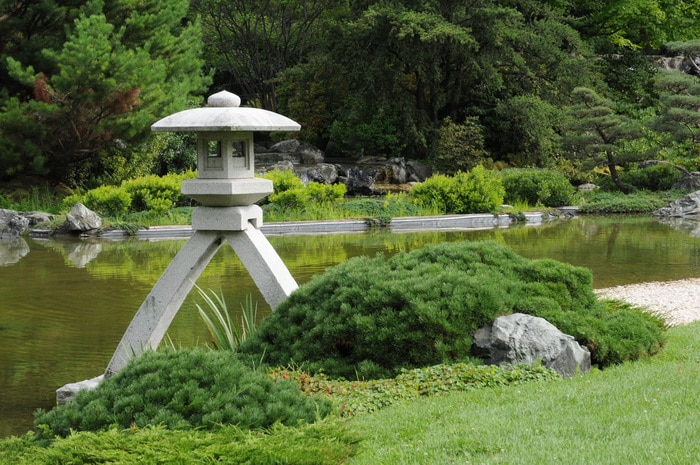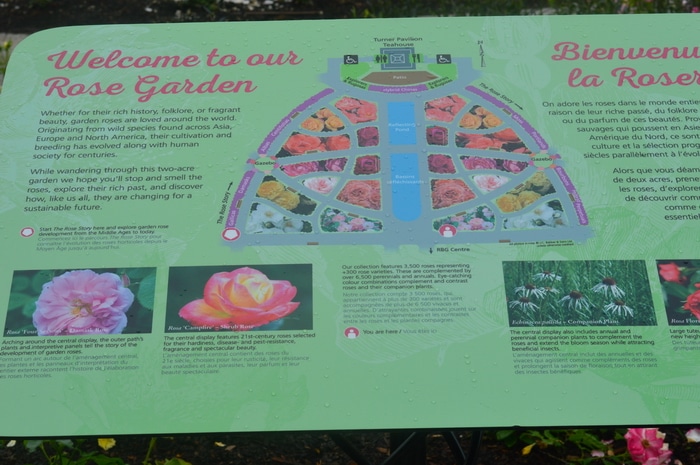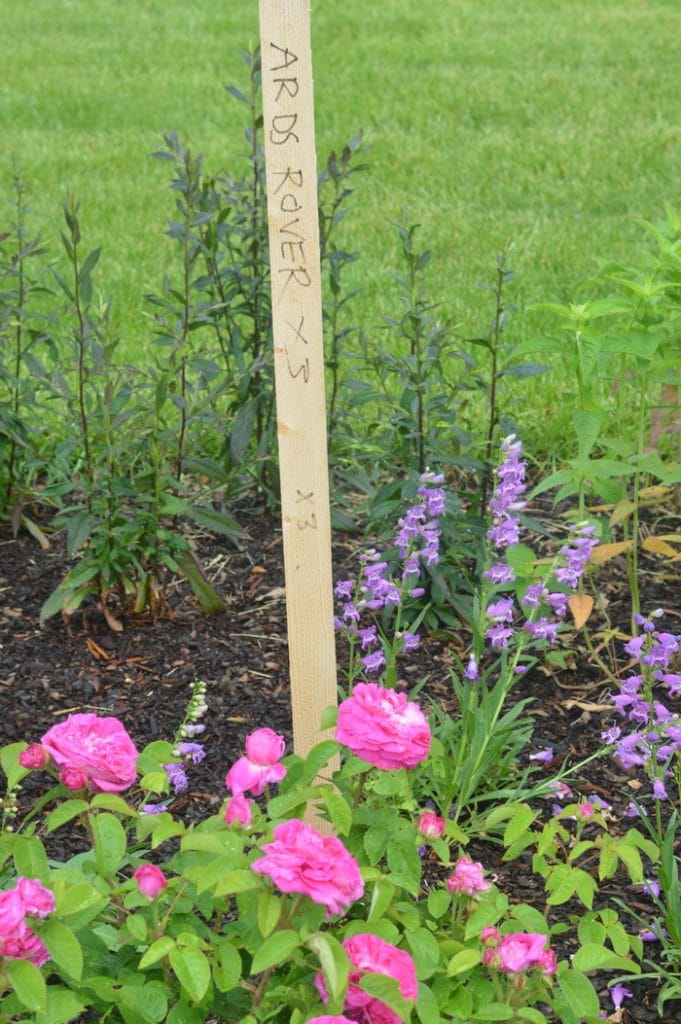Gardeners of all levels can benefit from visiting a botanical garden during any season. Botanical gardens are not just for city dwellers to connect with green spaces. They also provide inspiration, education, and wonder for those who have their own garden at home.
It was raining when we stepped out of the rental mini-Cooper at the Royal Botanical Gardens in Burlington, Ontario. It was the first day of our mini-vacation. We were on our way to Niagara Falls, but decided to take a detour.

I wanted to view the newly planted eco-rose garden, near Toronto, and see what made this sustainable rose garden cutting-edge. I wanted to learn what enticed the garden society to rip out their Centennial Rose Garden, planted in 1967, for Canada’s 100th birthday, and replace the disease-prone floribunda and tea roses with hardy heritage and garden shrub roses. I also wanted to learn more about growing roses organically. But I received much more than I was expecting for our impulsive detour to the Royal Botanical Garden.

Strike it rich rose
Just as we came out of the main building the rain stopped. It was a good sign. The blooming roses had drops of moisture which made them even more photogenic. We were a week early. The improved rose garden was scheduled to open to the public in 4 days. Fortunately a board member saw our interest in the roses and came by to answer our questions. It was a fabulous opportunity to talk gardening, roses, and economics. While I didn’t have $100,000 to invest in my own garden, the conversation did inspire me to seek out a few historical apothecary roses for my own garden this year.
There are many reasons that gardeners can benefit from visiting a botanical garden when they are travelling. I hope after reading this you’ll include a few botanical gardens in your own travel itinerary.
1. Inspiration
Just as I was inspired to seek out a few heritage roses from a rosarian after my trip to the Royal Botanical Garden, you might be surprised at the ideas that inspire your own garden plans. Seeing professional landscapes, buzzing with pollinators, blooming in a kaleidoscope of color, textures, and fragrance can open your eyes to bigger possibilities for your own backyard garden. You don’t need to do it all. Even adding one element — a bench, a rose arbor, or a linden tree, can inspire you to look at your garden with new eyes.

Butchart gardens, Victoria, BC, Canada
2. Nature trails
Botanical gardens are landscaped over several acres with groomed or paved paths that are accessible for all age groups. They are an ideal way to get out in nature even when you are limited in mobility or have young children in tow. They allow for leisurely strolls, just sitting on a bench and enjoying the buzzing of the bees and flowers dancing in the wind, or more intense aerobic effort. Some gardens have regular programs with Tai Chi or stroller aerobics to keep you coming back. Get a map of the garden before you visit so that you can plan your trek. If you plan to participate in a class, check with the garden before you visit. Some classes require reservations.
3. Education
Botanical gardens are staffed with professional landscapers, scientists, archivists, naturalists, bee keepers, or master gardeners. Part of many botanical gardens is a robust program of community education that may include demonstration gardens, public lectures, and even classes in subjects like botanical painting, composting, food forests, pruning, companion planting, bee keeping, or medicinal herbs. While these classes are aimed at members and locals, you might be able to participate in them when visiting the garden. Check the events page of the botanical garden’s website or call ahead with the dates you plan to visit, to see what might be happening during your visit.

Claude Monet’s Garden
4. To view historical collections and themed gardens
The original botanical gardens were actually pharmacies, that held living medicinal plants. Called physic gardens, they were often attached to monasteries or castles and served the community’s health needs. Many botanical gardens recreate these historical collections in an entertaining and educational way. You might find plant collections grouped according to their health benefits, as they were in the physic garden, or their plant family such as the Rose Garden, their cultural heritage, such as the Japanese garden or Monet’s garden in Normandy or even their eco-system, such as the Desert garden in Phoenix’s Botanical Garden.
5. To see plant specimens and learn how to recreate ecosystems
Visiting a botanical garden allows the gardener to see successful companion plants at work, allowing them to choose proven companions for their own gardens. Even simple observations like how close to plant rose bushes or how many echinacea to plant near the roses, can make a big difference in early spring, when the snow recedes and all you have are seed packages to draw inspiration from. Hint: plant four times as many companion herbs like echinacea and yarrow, as you have specimen plants like roses.
6. To observe demonstration beds
Botanical gardens have the means and ability to create demonstration beds without the risk of crop failure that the home gardener faces. Much can be learned by careful observation of these demonstration beds. Are they more or less fruitful; more or less prone to insect predation or mildew? The home gardener can gain insight into solutions for their own garden challenges by observing the written documentation that surrounds these demonstration gardens.
7. To engage with experimental gardens
Many botanical gardens host scientists that are actively engaged in garden research to solve contemporary problems in landscape, botany, climate, or health. The botanical garden is a laboratory as well as a catalog of specimens for these botanical scientists. Visitors to the botanical garden can often participate in the ongoing scientific research, making observations at home, or supporting the science as it happens, in the botanical garden.
8. To meet native plant species up close
Native plants are often the hardiest plants to grow in your own garden space. These plants are well suited to feeding native pollinators and wildlife, as well as offering habitat for butterflies and other beneficials. When you visit the botanical garden you’ll meet these native plant species and observe their leaf structure, flowers, and seeds, so that you’ll be able to identify them when you see them again, closer to home.
9. To observe global plant species
Here in zone 3, I’m unlikely to see roselle or lemon grass growing robustly. It’s unlikely my ginger or turmeric plant will ever flower — even when kept indoors. We’re just too cold and lack the intense sunlight necessary for their growth. But these plants are easy to find in some of the botanical gardens. By visiting botanical gardens when you travel you can see these distinctive plants in all their glory.

Japanese garden in the Botanical Garden of Montreal
10. To celebrate the culture and botany of other lands
Many botanical gardens include cultural themed gardens like the Japanese gardens at Montreal’s Botanical Garden. These themed gardens include ethnic structures, koi ponds and cultural flavor that celebrates and honors the heritage of many immigrants, as reflected in the plants they brought with them. Observing and enjoying these special landscapes inspires wonder and renews creativity for every gardener.
11. To be in nature
It is well documented that spending time in nature improves health, lowers blood pressure, increases mood, and improves immune function. Visiting a botanical garden is an easy way to connect with the health benefits of forest bathing, or spending time in nature. Even just sitting on a bench and enjoying the changing landscape has health benefits. Be sure to plan some nature time into your next vacation, by visiting at least one botanical garden.
12. To participate in culture events
Botanical gardens are more than just living plant catalogs. They are also meeting places. Many have restaurants or tea houses as part of the complex. They may also have an amphitheater or other space dedicated to public performance, where lectures and concerts are held, art shows are staged, and other public events draw people to the gardens. Check with the botanical gardens for your next vacation to see what events are happening during your visit. You might be able to take in an antique car show, a Shakespeare play, a musical fire works display, or a concert. Botanical gardens are a hidden treasures of inspiration, botanical wonder, science, and entertainment for the travelling gardener.
13. Preserve endangered plants
Lastly, botanical gardens are tasked with growing and preserving genetic diversity in plants. 20% of plant species are endangered. The global network of botanical gardens preserve about 60% of temperate plant species and about 25% of tropical plant species. Seed storage facilities preserve about 2/3rds of known food crop and medicinal seeds, however, 36% of plants have seeds that become nonviable if they are allowed to dry out, making it unfeasible to preserve them in seed storage facilities. Instead these plants must be kept alive in gardens and in the wild, in order to preserve them. Many botanical gardens hold annual plant sales of some of these at risk plants.

Make a visit to a Botanical Garden part of your next vacation itinerary
As you are planning your next vacation, plan to visit at least one botanical garden and tap into these 13 surprising benefits for gardeners. Check out these award winning Canadian botanical gardens.
What to pack?
Wondering what to pack for your day outing? Here’s a list, if you plant to travel light, but don’t want to miss the essentials.

As you are planning for your vacation be sure to include my course, The DIY Herbal First Aid Travel Kit class It will teach you how to make simple herbal remedies suitable for packing in your carry-on luggage or your camping backpack or your RV first aid kit. So you’ll always be prepared, even when you are away from home, for minor health challenges. Plus my course will teach you how to refill your supplies even if you are on the road or camping. You’ll never again be without the safe and effective remedies you need.







Leave a Reply